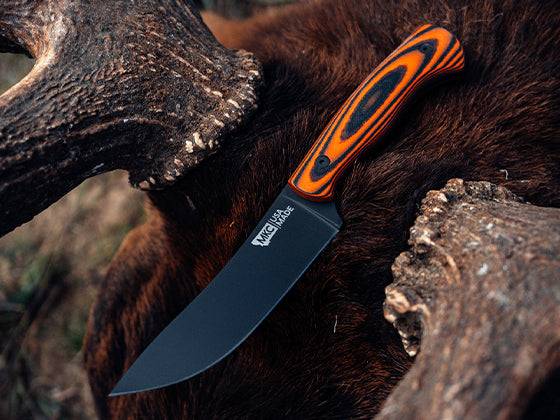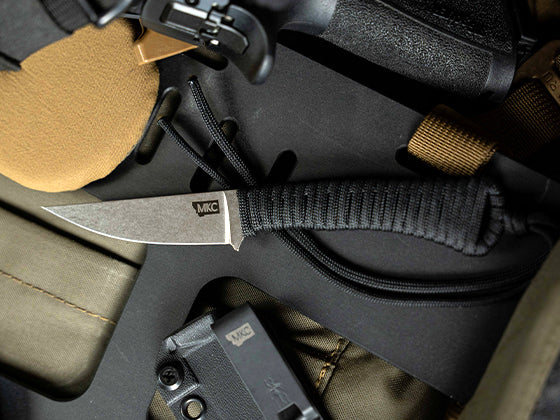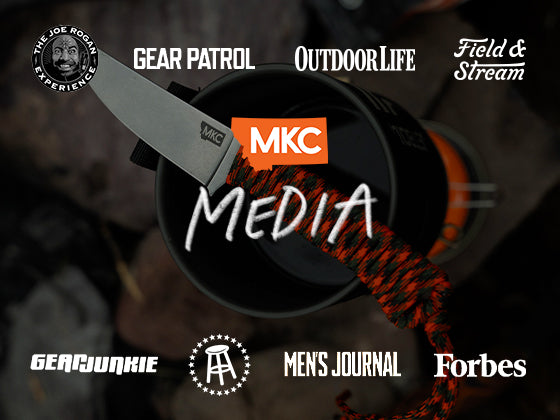Skinning knives (or skinner knives) are designed to separate the skin (or hide) of animals from the body without damaging the meat. A passionate hunter never ventures into the field without one.
High-quality skinning knives don’t have to be used exclusively for skinning; they can also cut and chop. The key word here is “high quality,” because not all skinning knives are created equal.
In this post, we’ll explain how to choose the best skinning knife and how to keep it in great shape for years to come.
Anatomy of a Skinning Knife
A practical skinning blade is thin, lightweight, curved, sharp, and fixed to the handle. It should have a sleek profile, which makes it easy to cut the skin along the animal’s carcass without inflicting damage.
As you look for your next skinning knife, consider the following features:
- The blade should be tough, wear-resistant, and easy to resharpen, which is determined by the type of steel it’s made from. More on this topic in a bit.
- The handle should provide a superior grip, even when wet or bloody. We recommend handles made of moisture-resistant G10.
- The shape of the blade should include a shallow curve and an enlarged belly. This allows for sweeping strokes while keeping animal hides intact.

The Best Skinning Knife Steel
The best skinning knife will likely be made from one of two types of steel: carbon steel or stainless steel.
Each material has pros and cons that may lead you to favor one over the other. We’ll explore these benefits and drawbacks and give our recommendations below.
Benefits of Carbon Steel
- Tough — Carbon steel is tough, shock-resistant, wear-resistant, and highly durable, which makes it an excellent option for a hunting knife.
- Affordable — Carbon steel is less expensive than stainless steel, keeping the cost of these knives lower.
- Sharp — Carbon steel is easier to sharpen (and to keep sharp) than stainless steel.
- Easy to Forge — Bladesmiths love carbon steel because it’s easier to forge and manipulate than stainless steel.
Drawbacks of Carbon Steel
- Corrosion — When carbon steel isn’t pre-oxidized, it’s more likely to rust or corrode.
- Dull — Carbon steel doesn’t have that shiny, reflective, mirrorlike finish stainless steel has.
- Heat Treatment — Carbon steel can become too hard or brittle when improperly heat treated.
Benefits of Stainless Steel
- Corrosion Resistance — Stainless steel rusts and corrodes at a slower pace than carbon steel.
- Heat Resistance — Stainless steel holds up in high-heat environments, which is why it’s used for pots, pans, kitchen knives, etc.
- Shiny — If you want a knife with a glossy, polished finish, stainless steel is ideal.
Drawbacks of Stainless Steel
- Cost — Stainless steel is significantly more expensive than carbon steel.
- Difficult to Forge — It’s much easier to “ruin” stainless steel when you’re forging a knife. Carbon steel is much more forgiving.
- Less Tough — Stainless steel hardens over time, which makes it wear-resistant, but also makes it less tough than carbon steel.
- Duller — Stainless steel knives are more difficult to sharpen than carbon steel knives, which may lead to duller (and more dangerous) blades.
Carbon Steel vs. Stainless Steel: Which Is Better?
While stainless steel has its benefits, we believe the best skinning knife is made of carbon steel. It’s the preferred knife material for most hunters.
Carbon steel knives are tougher, sharper, and have better edge retention than stainless steel knives, making them ideal for cutting through thick hides and skinning animals. Montana Knife Company’s skinner knife, the Stonewall, is made from 52100 high-carbon ball-bearing steel, a type of carbon steel that’ll never do you wrong.
One caveat: Stainless steel skinning knives may be preferable when hunting in wet saltwater environments.
Handle Materials and Ergonomics
Skinning an animal can take a significant amount of time, so choosing a knife with a comfortable, lightweight handle is essential. The best skinning knife has a handle that’s easy to clean and grip, even when it’s covered in blood.
MKC uses G10 to craft all our knife handles, including our skinning knives. Unlike natural wood, which can crack, splinter, or warp, G10 is a composite material made from durable fiberglass and epoxy resin designed to last a lifetime.
Maintenance and Care
Skinning knives can last for decades when properly cared for — but if neglected, they’ll quickly rust and corrode. Whether your skinning knife is made of stainless steel or carbon steel, here’s how you can keep your blade in great shape:
- Clean and dry your blade immediately with warm soapy water after using it. Rust forms more quickly when a blade stays moist for too long.
- Apply wax made with natural materials, like beeswax, to your blade every time you clean and dry your knife. A good blade wax will prevent moisture from sneaking in.
- Clean and dry your knife’s sheath to ensure your blade isn’t exposed to any saltwater, blood, or other moisture after you’ve cleaned and dried the knife itself.
- Saltwater can corrode carbon steel quickly, even if you maintain your blade perfectly. If you’re fishing, diving, or working near the ocean, use a stainless steel skinning knife instead of a carbon steel knife.
The Best Skinning Knife Safety Tips
Whether you’ve used knives hundreds of times before or you’re using your skinning knife for the first time, it’s important to keep the following safety tips in mind:
- Always assume a skinning knife is sharp and can cut you.
- Never point the blade of a knife at something you aren’t willing to puncture, and never pass the edge of a knife over a surface you aren’t willing to cut.
- Only hold a skinning knife when ready to use it. Knives are not toys.
- Think about the surface you’re skinning and what could be underneath that surface. Could your blade harm or injure someone or something else?

The Best Skinning Knife: Final Thoughts
Once you find the best skinning knife for your next hunt — one made with G10 and carbon steel — it’ll never leave your side. Skinning knives can last for decades when you keep them clean and dry and handle them with care.
Adhere to our tips, and you’ll never need to purchase another skinning knife.
by Josh Smith, Master Bladesmith and Founder of Montana Knife Company







































